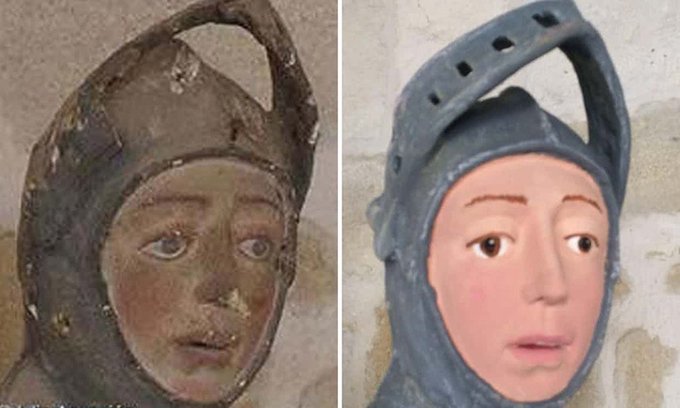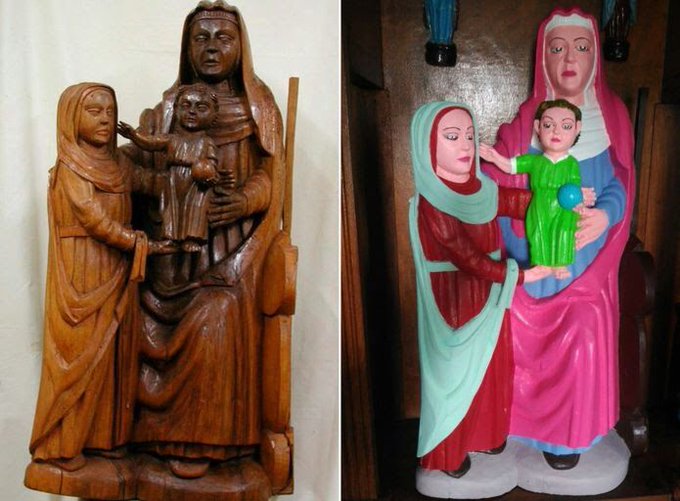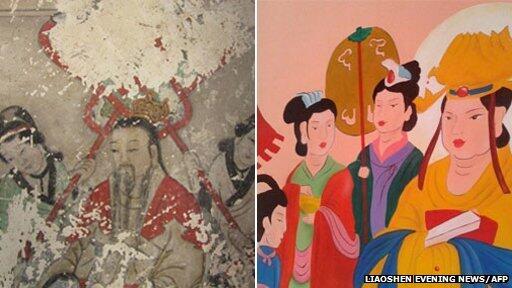Worst Art Restorations

July 3, 2023
•11 min read
Sometimes, restoring art to its former beauty is a difficult task. Let's dive into the world of strange and bad art restoration attempts.
Restoring a piece of priceless art is a big responsibility, but you’d be surprised just how often those entrusted with such a task miss the mark by a milestone. After taking a look at some of these terrible art restorations, you’ll see for yourself that the road to hell really is paved with good intentions.
Ecce Mono
Let’s kick things off with what has literally been dubbed “the worst restoration of all time”. A mother of all mistakes that burned through the internet like viral wildfire, leaving a trail of memes, cosplays, and even tattoos in its wake: ‘Ecce Mono’, which literally translates as ‘behold the monkey’.
But how did a centuries-old mural of Jesus end up looking like a sack of muddy spuds in a tunic? Well, the year was 2012, and the fresco painting, originally done by Elias Garcia Martinez, had remained on the wall of a cathedral in the small Spanish town of Borja since the 19th century.Old artwork is delicate, and as the church walls were moist the paintwork had started to flake, leaving Jesus looking rather patchy. A local 81-year-old woman named Cecilia Jimenez feared that the face of Christ would soon disappear forever, so she decided to do something about it. Jimenez claims to have touched up parts of the painting in the past, so the parishioner agreed to let her reach for the paintbrushes once more.Midway through her restoration, though, Jimenez left town for a trip; and that’s when the grave error really became apparent. A historical association came across the mural (which now bore the image of a bloated hedgehog) and suspected vandalism. Before-and-after shots were posted online, and by the time Jimenez returned she had no choice but to confess that “things had got out of hand”. There’s a twist in the tale, though, because Jimenez’s well-intended botch job actually ended up benefiting the town more than the original ever had. Between August and December of that year, nearly 46,000 people visited the sanctuary.Botched Statue Of St. George
Let’s fast forward 6 years to 2018 when a new artistic blunder arose to challenge Ecce Mono and topple Jimenez’s title for the most overzealous restoration job. This unfortunate tale also takes place in Spain, in the Church of St. Michael, Estella, where a rare 16th-century polychrome sculpture of the gallant knight St George slaying a dragon needed a wee freshen-up.
The colors had faded massively, and he was looking a little worse for wear, which is expected when you’ve been sitting in a Church for 500 years. The time had finally come for the Saint to be restored to his former grandeur, and with a few licks of paint, he was transformed into something that looks like a brightly colored McDonald’s toy.After the infamous ‘Monkey Jesus’ botched art restoration, one would think only a professional would be entrusted to restore this 500-year-old effigy of St George – unfortunately disaster has struck yet again: frieze.com/article/amateu…
Botched Spanish Statues
A few months after the bungled St George statue gained global notoriety, another case of ancient artwork falling prey to a well-meaning amateur emerged again in Spain. This time, it was a collection of late-15th-century religious wooden statues that were on the proverbial chopping block.
The statues sat in a tiny shrine in a chapel in El Ranadorio, Asturias, and included a trinity depicting The Virgin Mary and Child with St Anne, a solitary St Peter, and one of Mary and the baby Jesus in natural, muted tones.Although they had been tastefully restored in 2002, A local tobacco shopkeeper named Maria Luisa Menendez decided that the statues could do with what she called “a fresher look” and obtained permission from the parishioner to do so. What ensued that summer was a restoration job that transformed the 500-year-old statues into what can only be described as something you’d find in a Kinder surprise egg.Spain parishioner botches Jesus and Mary statue restoration. buff.ly/2CyEmj6
"Effeminate" San Antonio Statue
Botched restoration jobs aren’t unique to Spain. In September 2018, a Colombian church suffered a similar case of a misinformed makeover when parishioners in Soledad decided it was time for a wooden statue of San Antonio de Padua to get a long-overdue touch-up.
The statue was carved in the 17th century and had been badly damaged over time, so they commissioned an artist to restore it, but what they got was far more than they bargained for. Thanks to the artist's not-so-careful brush strokes, poor Antonio now looked like he’d gone wild on the bargain-bin items at Claire’s Accessories.The statue literally looked like it had followed a contouring tutorial on YouTube. With heavy blusher, purple eyeshadow, shimmering lip-gloss, and those unmistakable brows, Antonio looks like he’s about 5 seconds away from switching on the vlog camera and shouting “Hi Sisters!”.Botched Buddha Restorations
The local government of Anyue County in south-east China’s Sichuan province was forced to make an official apology in 2018 after a 1000-year-old stone Buddha statue was given an unsightly makeover. The Anyue County prides itself on being home to more than 100,000 sculptures dating back as early as the 900s across the township.
This ancient sculpture, once a majestic and sacred symbol, now looked like it had just stepped out of the red-light district, with a paint job that could have been done by a pre-schooler and a makeup job harsh enough to be seen from miles away. What was once a suggestive halo behind the figure had now been dolled up in block colors so that it resembled a giant lollipop or a technicolor dart board instead. Most surprising was that the botched restoration job was actually carried out by well-intentioned villagers in 1995, but it was only bought to public attention after Xu Xin, a tour guide at the Dunhuang Grottoes in Gansu Province, posted the pictures on his Weibo account.In 2013, a similar incident occurred in a 270-year-old temple in Liaoning province, when a collection of centuries-old Buddhist frescoes was ruined after an unauthorized restoration job. The original artwork, which dated to the early period of the Qing Dynasty, was completely lost as the perpetrator opted for a replacement that looked like a page had been torn out of a colorful children’s storybook and pasted on top.Two officials in China sacked after "restoration" work ruined Buddhist frescos - state media bbc.in/1cbXsYr
Mystic Lamb Restoration Gone Wrong
The Ghent Altarpiece, also known as ‘the Adoration of the Mystic Lamb’, is one of the most-stolen artworks in the world, having been swiped and nearly destroyed on 6 separate occasions in history. This 15th-century oil painting by brothers Hubert and Jan van Eyck, which is made up of 12 separate panels, is laced with Catholic mysticism, and at its center is a depiction of an iconic scene showing a lamb being sacrificed to God.
Given the turmoil the painting has been through over the years, it suffered a fair amount of damage, and since 2012 a $2.4 million project to restore the artwork has taken place at a museum in Belgium. In the second phase of the project, which ended in December 2019, restorers made some interesting discoveries. As they chipped away at the old yellowed paint they unwittingly revealed the disturbingly humanoid face of the sacred lamb. This haunted lamb instantly shook the Twitter-sphere, with people divided over the sudden discovery that the wizened and enigmatic lamb they were used to seeing was a mere guise for what is so clearly a human trapped in a lambs body.In fact, its over-enhanced pout looks eerily like what Kylie Jenner might look like if she was transformed into a sheep by some sort of hex. According to experts, it wasn’t uncommon for Middle-Age painters to depict animals with forward-pointing eyes and squished features.A Holy Decapitation
Our final tale of blindsided destruction takes us over to Canada, and this one’s a real head-turner. The year was 2016, and the Sainte-Anne-des-Pins Catholic Church in Sudbury, Ontario was suffering a recurring vandalism problem, with a mid-20th century white stone statue of Mary and the baby Jesus as the prime target.
Careless vandals were obsessed with repeatedly decapitating poor Christ, and one day his head disappeared altogether. After contacting local businesses, the church’s priest Gérard Lajeunesse was told that a custom replacement would likely cost as much as $7,500. That’s where local artist Heather Wise comes in.Wise knocked on Lajeunesse’s door and explained that she felt saddened by the thoughtless attack on the statue, which inspired her to offer to replace the head for free. Wise had learned how to sculpt at college and spent hours creating the replacement. It seemed the church’s prayers were finally answered until Wise presented her finished product.The infant body of Christ was suddenly adorned with an orange terracotta sculpture of what could only be Maggie Simpson’s head, much to the dismay of local residents. It became the subject of ridicule as the internet responded with comments like “no wonder Mary has her eyes closed” while Gérard Lajeunesse himself expressed his disbelief.


























